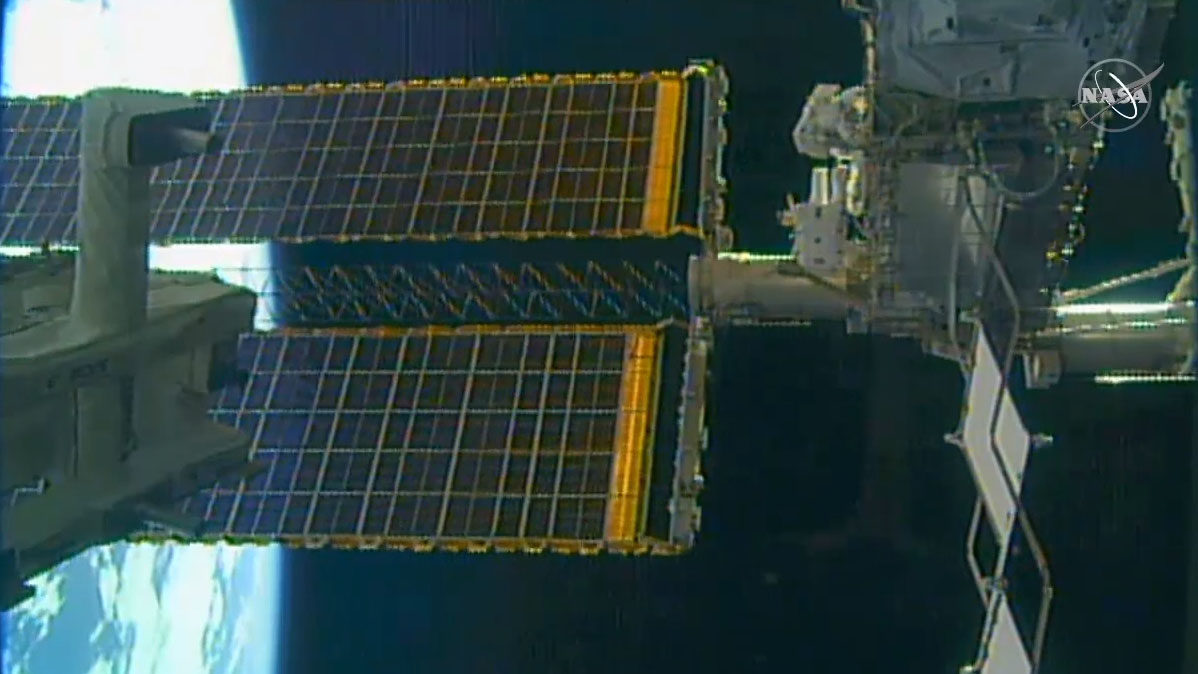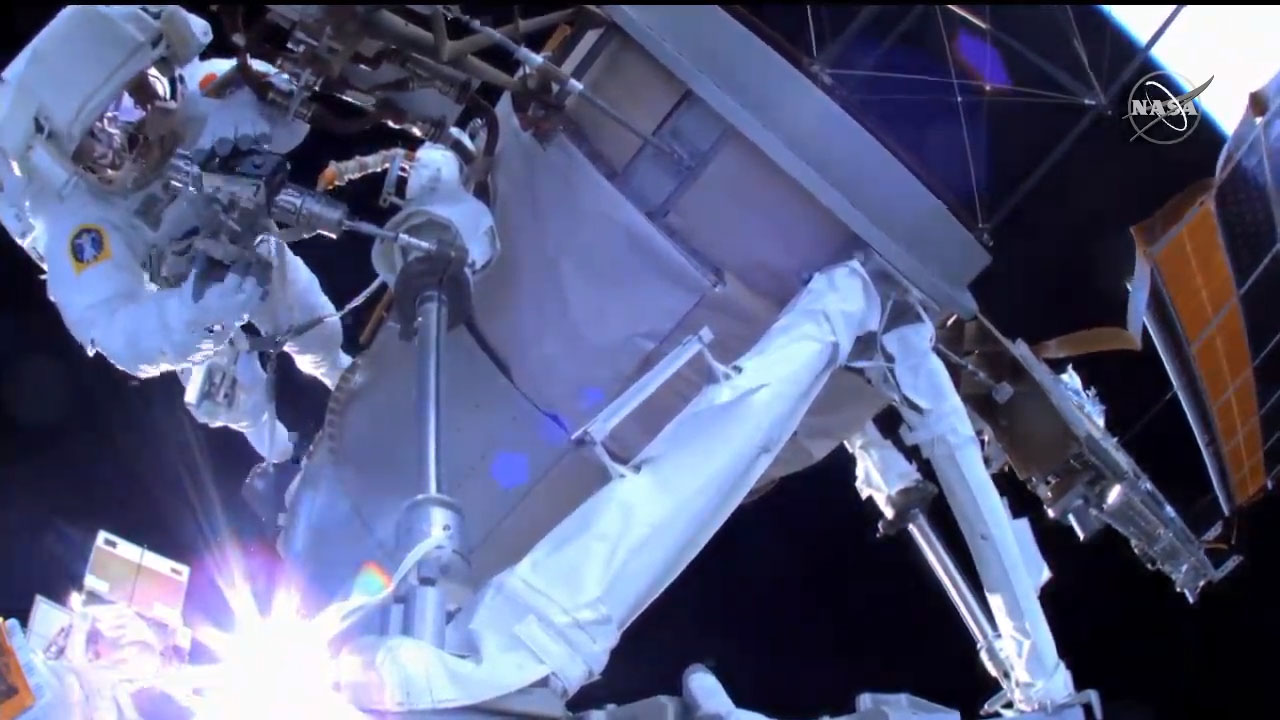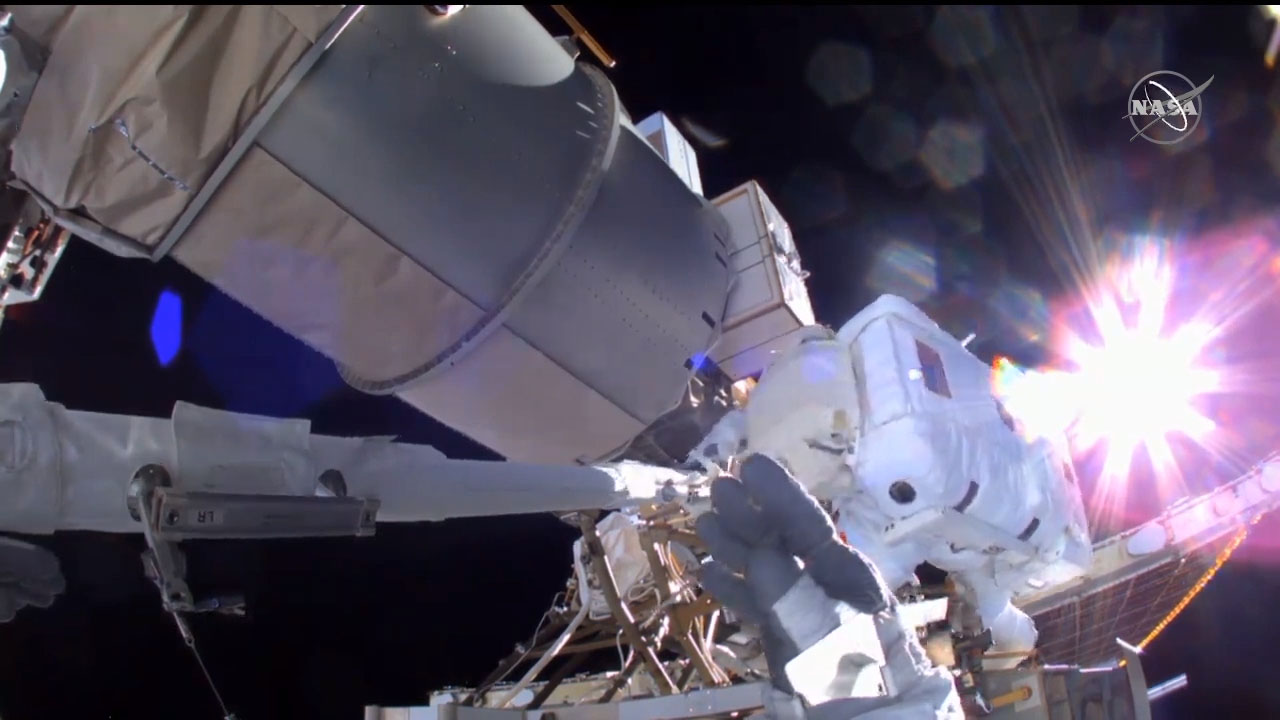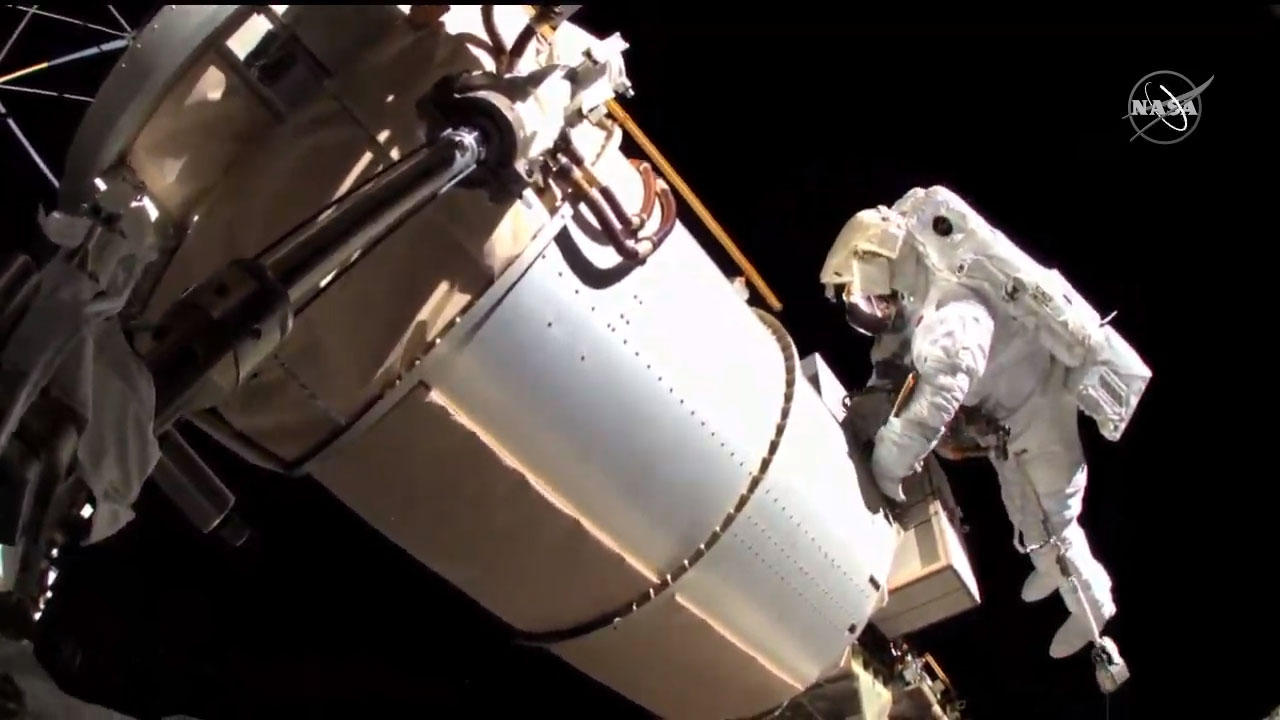Spacewalking astronauts tackle stubborn struts to prime space station for new solar arrays
A second spacewalk was the charm for stubborn struts on the space station.

Two astronauts finally wrapped up tricky solar array strut installations outside the International Space Station Friday (March 5) that stymied a previous set of spacewalkers just a few days before.
Expedition 64 astronauts Kate Rubins of NASA (wearing a red-striped spacesuit) and Soichi Noguchi of the Japan Aerospace Exploration Agency) spent 6 hours and 56 minutes working in the vacuum of space, most of that time dangling unusually far away from the core of the International Space Station (ISS).
They worked at a distant location at the station's port side to continue upgrade work on the aging 4B and 2B solar panels. The panels were first installed during space shuttle mission STS-97 in 2007 and have naturally degraded over time.
Related: The International Space Station inside and out (infographic)
NASA's goal is to eventually add a new set of Boeing-manufactured panels on top of each of the station's eight arrays to boost current station power levels by 20% to 30%. Those solar panels will be shipped on a future SpaceX Dragon cargo mission, but first, the spacewalkers had to get the support struts in place.
The astronauts switched over to spacesuit battery power at 6:37 a.m. EST (1137 GMT) — officially starting the spacewalk — and exited the U.S. Quest airlock. From there, the spacewalkers made a hard left and moved hand-over-hand along the P6 structure.
"We'll go slow," Noguchi said cheerfully after NASA gave the authorization to venture far out on the station's port side. It was a long journey, taking the astronauts several minutes to accomplish. "Keeping my tethers clear," Noguchi reported as he carefully threaded his way along the truss, attached to the space station with safety lines.
Get the Space.com Newsletter
Breaking space news, the latest updates on rocket launches, skywatching events and more!

There, they continued work from the spacewalk last Sunday (Feb. 28), by Rubins and NASA astronaut Victor Glover. Rubins wrestled to get herself and an articulated portable foot restraint (APFR) in the right position to look at the first work site, at the 4B solar array panel.
"I'm in the perfect body position for that APFR now," she reported to Mission Control.
Rubins and Francisco Rubio, the "intravehicular crewmember" in Houston sending instructions from Mission Control, compared her efforts to working in "the pool." That pool is the Neutral Buoyancy Laboratory in Houston, a swimming facility where astronauts practice spacewalks before flight.
"Unfortunately, I think we get the easier positions in the pool," Rubio joked from Mission Control.
"It's not so bad," Rubins quipped, working in microgravity well into her fourth spacewalk.
A glitch popped up almost immediately for Rubins, as she worked to bolt the already assembled "upper triangle" struts of a modification kit into place, at the 4B solar array. Three of the four bolts moved in smoothly with her pistol grip tool — a sort of modified space drill — but the fourth wasn't cooperating. Rubins moved the bolt in and out of place and said she wasn't seeing it securing properly.
Rubio consulted with his colleagues on the ground to see what to do next, and the consensus in Mission Control seemed to be that the last bolt wasn't needed after all. "We are good with three of four bolts [secured], so we're going to press and call this a good install," he reported.

Rubins' next task was to move back out of the foot restraint to receive more struts from Noguchi. Removing herself from her fixed spot took some effort. "And I am out of here," she gleefully reported after several more minutes of effort.
The astronauts had fewer problems putting the other struts into place on 4B, and regularly thanked each other for keeping track of all the pieces. Next, they moved to a second worksite to troubleshoot a sticky bolt on 2B's array modification kit that delayed some of its planned installation work by almost a week.
Proceeding carefully, Mission Control and the astronauts drove in the required bolts and finally secured all the 2B mod kit struts to the ISS, finishing the work starting on Sunday. The only minor mar to the work was when Rubins spotted a "pinpoint" abrasion on her right glove. No leak was detected, but Rubins requested that she stick close to her colleague for the rest of the spacewalk — just in case.
Related: What it's like to work in space, using bulky EVA gloves

Approaching the six-hour mark of a planned 6.5-hour spacewalk, NASA looked at remaining levels of oxygen and water in the spacesuits to assess whether to proceed with any "get-ahead" tasks the spacewalkers could pursue if they had the time. The agency ultimately decided not to go ahead, and to hold the additional tasks for a future spacewalking crew. These non-urgent tasks included cabling at the European Space Agency's new Bartolomeo external platform for science experiments, and removing and replacing a system that receives video from spacewalkers.
With the main work of the spacewalk thus complete, Noguchi and Rubins cleaned up the 2B array worksite, made the long journey back to the station core along the P6 truss, then climbed back inside the Quest airlock for repressurization. The spacewalk concluded at 1:33 p.m. EST (1833 GMT).

Friday's spacewalk was the 236th spacewalk in support of space station assembly; it was the fourth each for Rubins and Noguchi, with Noguchi breaking the record for most Japanese spacewalks. Sunday's spacewalk had seen Noguchi and Akihiko Hoshide each tied for the Japanese record, with three spacewalks each, according to remarks on NASA Television.
The most spacewalks for a woman is seven, a record shared between NASA astronauts Peggy Whitson and Sunita Williams; Whitson has almost three hours more cumulative time "outside" than Williams, with a total of 53 hours and 22 minutes on extra-vehicular activity.
The ground support team included Rubio, capcom and NASA's record-breaking astronaut Christina Koch, flight director Chris Edelen, and lead spacewalk officer Art Thomason. NASA Expedition 64 astronauts Glover and Mike Hopkins (the suit-up lead) helped the spacewalkers from inside the space station.
Follow Elizabeth Howell on Twitter @howellspace. Follow us on Twitter @Spacedotcom and on Facebook.
Join our Space Forums to keep talking space on the latest missions, night sky and more! And if you have a news tip, correction or comment, let us know at: community@space.com.

Elizabeth Howell (she/her), Ph.D., was a staff writer in the spaceflight channel between 2022 and 2024 specializing in Canadian space news. She was contributing writer for Space.com for 10 years from 2012 to 2024. Elizabeth's reporting includes multiple exclusives with the White House, leading world coverage about a lost-and-found space tomato on the International Space Station, witnessing five human spaceflight launches on two continents, flying parabolic, working inside a spacesuit, and participating in a simulated Mars mission. Her latest book, "Why Am I Taller?" (ECW Press, 2022) is co-written with astronaut Dave Williams.









